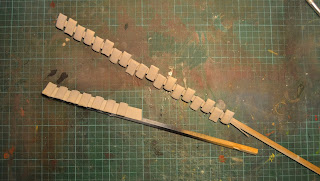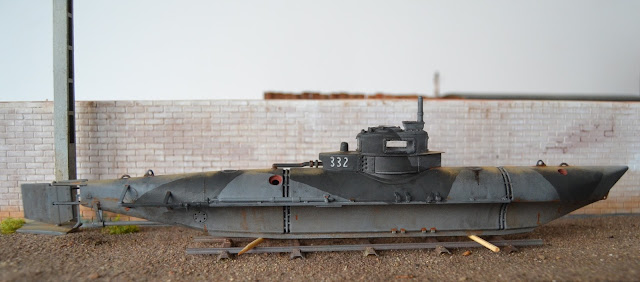 |
| A narrow gauge train at the small halt Broløkke. The railway usually carried firewood. In the background a short standard gauge goods train. Photo: Arne Nielsen. |

Sunday, 29 January 2017
Langeland Narrow Gauge (1/35)
As I mentioned last week a few of my sacks with foundry sand had been sent to Langeland. On the island of Langeland a small machine shop was a regular user of
Multisand. From the SG station a narrow gauge railway took the sand to
the works. I have been fortunate to receive some images from Langeland
showing just such a transport.
Despite modelling in a scale and theme not shared by many I'm lucky to have a few good friends modelling in 1:32/1:35 I can cooperate with. We send each other tips and share parts when we can. Most important we provide inspiration to each other and I benefit greatly by being 'pushed' to the modelling bench when I see the progress done by my friends. I have shared images from Arne's narrow gauge railway before. You can see more on this site from time to time, but be warned: most of it is Gauge 1, 1:32 and standard gauge!
Monday, 16 January 2017
Foundry Sand to Langeland (1/35)
Nystrup Gravel's Multisand for foundry use found users in both Denmark and abroad. One small user was a machine shop on Langeland, one of Denmark's many small islands.
It had been my intention to make the Multisand sacks for the second Hudson bogie wagon at a later stage. But having the task on my list, I decided to finish it before I got too involved with other projects. During the weekend I finished 26 sacks, sealing paint and decals with a layer of matt varnish. Four of the sacks are now on their way to a friend's 1:32 scale railway on Langeland.
The weekend wasn't only spent modelling. I also worked on the heritage railway HVB. Moving a Dutch built diesel loco to our storage shed.
 |
| An old Ford AA-lorry at the truck stop in Nystrup with foundry sand for Langeland. |
It had been my intention to make the Multisand sacks for the second Hudson bogie wagon at a later stage. But having the task on my list, I decided to finish it before I got too involved with other projects. During the weekend I finished 26 sacks, sealing paint and decals with a layer of matt varnish. Four of the sacks are now on their way to a friend's 1:32 scale railway on Langeland.
 |
| Sacks primed. The sacks are mounted on two rocket sticks (from fireworks rockets) with double sided tape. Makes handling very easy. |
 |
| Decaling in progress. Cut out decals at right over brush and tweezers. Plate with water in the center and decal softener to the left. Painted sacks left - some of them with decals. |
 |
| Jacking down a four wheel diesel loco built in the Netherlands by Spoorijzer in Delft. In 785 mm. gauge the loco is now going into storage. Here I'm working with a mate 20 years younger than me. But I kept up the pace! More images on the HVB members' blog. |
Friday, 6 January 2017
Scrap Behind the Loco Shed (1/35)
In december I wrote that one of the drop down side doors from the flat bogie wagons resided behind the shed. Some readers could think that was just a story I had made up to avoid fixing doors to the wagons. While I can't say that such a suspicion is completely unfounded I can at least show evidence of a door from one of the Hudson wagons leaning against the side of the loco shed.
Right from when I started the loco shed module it was my intention to have a collection of scrap behind the shed. Over the years I have added a piece or two just as it happens in reality. The last few years hasn't seen any old iron added so when I built the two Hudson wagons I took the trouble to solder up one door, paint, weather and place it behind the shed. As I see it no loco shed on an industrial narrow gauge railway would be complete without this type of clutter. And what better way to use some of the extra parts most modellers collect over the years?
 |
| On other modellers' layouts I always try to identify from which kits the scrap originates. I hope to have made my scrap collection almost unidentifiable. |
Right from when I started the loco shed module it was my intention to have a collection of scrap behind the shed. Over the years I have added a piece or two just as it happens in reality. The last few years hasn't seen any old iron added so when I built the two Hudson wagons I took the trouble to solder up one door, paint, weather and place it behind the shed. As I see it no loco shed on an industrial narrow gauge railway would be complete without this type of clutter. And what better way to use some of the extra parts most modellers collect over the years?
Wednesday, 4 January 2017
Submarine Ready for Scrap (1/35)
My little adventure modelling a very unusual object without any railway relevance is now over. The 1:35 Biber submarine is ready to be transported to the scrap merchant. Having undergone technical evaluation by the British all the miniature submarines at the German air base at Mellemaaen were ordered scrapped. In the photo below the sub still awaits pick up by a heavy lorry.
Before I primed the model I masked the 'cockpit' windows with Humbrol Maskol. What looks as oversprayed windows in the image below isn't quite so bad. The Maskol peels easily away when all painting is finished.
I air brushed a medium grey over the primer and hand painted a dark grey disruptive scheme. I only painted dark grey areas on the upper surfaces, leaving the bottom without camouflage. The weathering is a combination of washes with thinned oil paints, pastel chalks and a little gloss varnish for the wet oil spots.
Before I primed the model I masked the 'cockpit' windows with Humbrol Maskol. What looks as oversprayed windows in the image below isn't quite so bad. The Maskol peels easily away when all painting is finished.
 |
| The sub with a cover of primer. Here posed on two narrow gauge flat wagons. |
I air brushed a medium grey over the primer and hand painted a dark grey disruptive scheme. I only painted dark grey areas on the upper surfaces, leaving the bottom without camouflage. The weathering is a combination of washes with thinned oil paints, pastel chalks and a little gloss varnish for the wet oil spots.
 |
| The Biber with basic painting done - two dark greys and a little red for primer under the missing covers. Decals are from the spares box - probably from a tank kit. |
 |
| August 1946 north of Nystrup. A British soldier looks at a mini sub. The sergeant major is obviously not close judged by the soldier's relaxed clothing. |
 |
| One last look at the submarine. The British painted yellow numbers on all the subs at Mellemaaen airfield. |
Subscribe to:
Comments (Atom)





